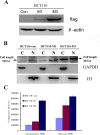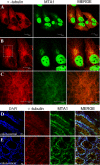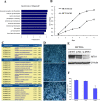The subcellular distribution and function of MTA1 in cancer differentiation
- PMID: 24970816
- PMCID: PMC4148129
- DOI: 10.18632/oncotarget.2095
The subcellular distribution and function of MTA1 in cancer differentiation
Abstract
The functions and mechanisms of metastasis-associated protein 1 (MTA1) in cancer progression are still unclear due to a lagged recognition of the subcellular localization. In the present study, using multiple molecular technologies we confirmed for the first time that MTA1 localizes to the nucleus, cytoplasm and nuclear envelope. MTA1 is primarily localized in the nucleus of normal adult tissues but in the cytoplasm of embryonic tissues. While in colon cancer, both distributions have been described. Further investigation revealed that MTA1 localizes on the nuclear envelope in a translocated promoter region (TPR)-dependent manner, while in the cytoplasm, MTA1 shows an obvious localization on microtubules. Both nuclear and cytoplasmic MTA1 are associated with cancer progression. However, these functions may be associated with different mechanisms because only nuclear MTA1 has been associated with cancer differentiation. Overexpression of MTA1 in HCT116 cells inhibited differentiation and promoted proliferation, whereas MTA1 knockdown resulted in cell differentiation and death. Theses results not only suggest that nuclear MTA1 is a good marker for cancer differentiation diagnosis and a potential target for the treatment of cancers but also reveal the necessity to differentially examine the functions of nuclear and cytoplasmic MTA1.
Figures








Similar articles
-
Subcellular localization of MTA proteins in normal and cancer cells.Cancer Metastasis Rev. 2014 Dec;33(4):843-56. doi: 10.1007/s10555-014-9511-7. Cancer Metastasis Rev. 2014. PMID: 25398252 Review.
-
Metastasis-associated protein 1 nuclear expression is associated with tumor progression and clinical outcome in patients with non-small cell lung cancer.J Thorac Oncol. 2010 Aug;5(8):1159-66. doi: 10.1097/JTO.0b013e3181e04d98. J Thorac Oncol. 2010. PMID: 20661085
-
Protein kinase D1 regulates subcellular localisation and metastatic function of metastasis-associated protein 1.Br J Cancer. 2018 Feb 20;118(4):587-599. doi: 10.1038/bjc.2017.431. Epub 2018 Feb 20. Br J Cancer. 2018. PMID: 29465084 Free PMC article.
-
Comprehensive analysis of the expression of the metastasis-associated gene 1 in human neoplastic tissue.Arch Pathol Lab Med. 2006 Jul;130(7):989-96. doi: 10.5858/2006-130-989-CAOTEO. Arch Pathol Lab Med. 2006. PMID: 16831056
-
The role of the MTA family and their encoded proteins in human cancers: molecular functions and clinical implications.Clin Exp Metastasis. 2009;26(3):215-27. doi: 10.1007/s10585-008-9233-8. Epub 2008 Dec 31. Clin Exp Metastasis. 2009. PMID: 19116762 Review.
Cited by
-
Membranous CD44v6 is upregulated as an early event in colorectal cancer: Downregulation is associated with circulating tumor cells and poor prognosis.Oncol Lett. 2021 Dec;22(6):820. doi: 10.3892/ol.2021.13081. Epub 2021 Oct 8. Oncol Lett. 2021. PMID: 34691247 Free PMC article.
-
MTA1 regulates higher-order chromatin structure and histone H1-chromatin interaction in-vivo.Mol Oncol. 2015 Jan;9(1):218-35. doi: 10.1016/j.molonc.2014.08.007. Epub 2014 Aug 27. Mol Oncol. 2015. PMID: 25205035 Free PMC article.
-
Metastasis-associated protein 3 in colorectal cancer determines tumor recurrence and prognosis.Oncotarget. 2017 Jun 6;8(23):37164-37171. doi: 10.18632/oncotarget.16332. Oncotarget. 2017. PMID: 28418887 Free PMC article.
-
Structure, expression and functions of MTA genes.Gene. 2016 May 15;582(2):112-21. doi: 10.1016/j.gene.2016.02.012. Epub 2016 Feb 9. Gene. 2016. PMID: 26869315 Free PMC article. Review.
-
Role of MTA1 in cancer progression and metastasis.Cancer Metastasis Rev. 2014 Dec;33(4):879-89. doi: 10.1007/s10555-014-9515-3. Cancer Metastasis Rev. 2014. PMID: 25344802 Free PMC article. Review.
References
-
- Toh Y, Pencil SD, Nicolson GL. A novel candidate metastasis-associated gene, mta1, differentially expressed in highly metastatic mammary adenocarcinoma cell lines. cDNA cloning, expression, and protein analyses. J Biol Chem. 1994;269:22958–22963. - PubMed
-
- Toh Y, Pencil SD, Nicolson GL. Analysis of the complete sequence of the novel metastasis-associated candidate gene, mta1, differentially expressed in mammary adenocarcinoma and breast cancer cell lines. Gene. 1995;159:97–104. - PubMed
-
- Pencil SD, Toh Y, Nicolson GL. Candidate metastasis-associated genes of the rat 13762NF mammary adenocarcinoma. Breast Cancer Res Treat. 1993;25:165–174. - PubMed
-
- Toh Y, Nicolson GL. The role of the MTA family and their encoded proteins in human cancers: molecular functions and clinical implications. Clin Exp Metastasis. 2009;26:215–227. - PubMed
-
- Xue Y, Wong J, Moreno GT, Young MK, Cote J, Wang W. NURD, a novel complex with both ATP-dependent chromatin-remodeling and histone deacetylase activities. Mol Cell. 1998;2:851–861. - PubMed
Publication types
MeSH terms
Substances
LinkOut - more resources
Full Text Sources
Other Literature Sources
Molecular Biology Databases
Research Materials
Miscellaneous

